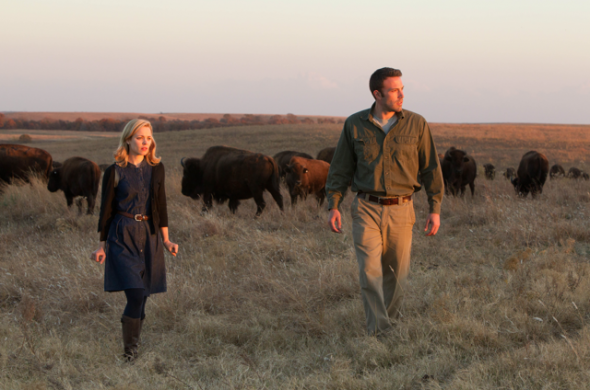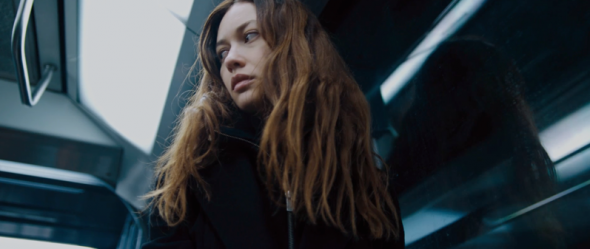by Danny Marroquin
Terrence Malick’s “To the Wonder” was shot in Bartlesville, Oklahoma and had a premier there at the Bartlesville Community Center April 12. It opened in New York City and other large cities the same weekend. It was then made available through On Demand and iTunes. Now, this weekend Oklahoma City film buffs can catch it on the big screen at the Oklahoma City Museum of Art. Thursday, May 9, 7:30 p.m. … Friday & Saturday, May 10 & 11, 5:30 p.m. & 8 p.m. Sunday, May 12, 2 p.m.
“To the Wonder” opens with an in-love couple recording digital video together in France. An Oklahoman, Neil (Ben Affleck), and an Ukranian, Mariana (Olga Kurylenko), wander through France with Mariana’s ten-year old daughter in tow. In France they see the glory of the old world at Mont Saint Michel. In a striking juxtaposition the film cuts to the flatlands of Bartlesville, Oklahoma where Neil works for an oil and/or gas company. It is made clear that this will be a movie about love, for Mariana has traveled the sea for love. However, this isn’t shown with scenes heavy on dialogue; we just have to trust the intense intimacy of Malick’s camera. Will Neil and Olga’s love survive the displacement of location?
Given that Malick is a Rhodes Scholar from Bartlesville and Waco, TX, he knows a little something about the effects of rootlessness. But I have a suspicion that even his own international autobiography has been challenged by the world he is looking at today. It’s not just the well-educated and artistic types who are well-traveled, but pretty much anyone else with a compelling or trifling reason could be as well.
Affleck’s Neil is a man employed no doubt by a company that has reach all over the world. And with that comes a lack of a commitment to one place. Mariana wants to come with him, she has a daughter; but he seems to neither approve or disapprove whether she comes back with him. In the set design we see his mattress is plopped on the floor without a bed frame. In the dining rooms Malick is so fascinated by, items are left in their moving boxes. There is a strong feeling of love between him and Mariana, but where this intimate story differs from “The Tree of Life” is that there is no family. And that is the difference between “Tree of Life’s” Waco, Texas circa the 1950s and the rootless love of “To the Wonder.” It is not explicitly said in the film, but judging by the amount of time between Neil’s marriage to Mariana and their divorce, it’s clear the movie takes place in one of the divorce capitals of the country, if not the world.
Meanwhile Javier Bardem plays a Spanish priest, Father Quintana, schooled in Europe, who finds himself deeply confused by his surroundings. Much in the way any foreigner might be confused by a town like Bartlesville. A town long controlled and populated by the Phillips Petroleum company. Bartlesville was the incubator to some of the smartest students ( “Bartians,” its sometimes joked) I met while in school at OU. So you have this sort of intelligent elite, and a company that can afford to put decent public schools in Bartlesville where everyone has an opportunity. But nevertheless you still have the small town element that may perplex outsiders, because at the same time you have people living in a state of poverty in this supposedly close-knit community.
And “To the Wonder,” perhaps to the confusion or vague uneasiness of the people in Bartlesville, is mostly concerned with the latter, the under served. The spirited black man washing the windows, and the handicapped boy who is lovingly thankful Javier is in town, these are characters filled with a kind of life that evade the million dollar lead actors. People in the parish talk to Quintana about wanting to expand the church, while he keeps going without to visit the houses of the poor and suffering. This concern evokes the thinking of Gustavo Guttierez in his “On Job: God-Talk And the Suffering of the Innocent.” His book, written largely out of the theologian’s experience living amongst the suffering of Lima, is written under the assumption that God speaks most vividly to and from the people of misfortune. Quintana the foreigner seems unusually concerned with the suffering of the poor side of Bartlesville. He visits the prisons, the failing shacks, and he puts clothing on the shoulders of the meek. Privately, he can’t understand why God allows this kind of failure over and over again.
Malick’s latest film is not his best, as my filmmaking friend/partner Mickey Reece vigorously points out. Compared to how innovative Malick’s voice over and natural lighting style was in the 70s, and compared to the intricate production design and storytelling of “The Thin Red Line,” “To the Wonder” runs as a hastily conceived project, technically. But when viewed back-to-back with “The Tree of Life,” “To the Wonder” starts to carry a peculiar weight in the strength of its ideas on spirituality in the United States at this time. Like Clint Eastwood, Malick has gotten more inward and prolific the older he gets, and he seems to have his ideas all in a line. There was a scene in “Tree of Life” where Jessica Chastain fed water to a chained convict. This moment felt like an extraordinary or odd occurrence to me, so it’s interesting that “To the Wonder” delves into even more scenes like that.
“Tree of Life” was an ambitious film concerned with the creation of the Earth and the creation of the nuclear family. But now in 2013 in Bartlesville, Oklahoma we are presented with characters who demonstrate that creating the same kind of family is probably impossible. And when you try to live alone with Jesus like Father Quintana, well that’s not an easy life either.
Shots of streams, running horses and quivering wheat let us know that life on Earth is a volatile and ever changing thing. “You thought there was no time,” Mariana laments to her lover who is slipping away. And she’s right. In fact Neil doesn’t seem to be thinking about anything. He has been with another woman, Rachel McAdams’s rancher Jane, while Mariana was away back in France. This brief detour carries surprisingly a lot of weight when Neil and Jane break up later. Love comes and goes, and maintaining it would be something of a miracle, and, it must be said, one for which Malick is willing to sit around with a fully paid film crew and wait. In the meantime Malick has his many questions. In one thought experiment he uses Mariana’s friend who is presented as a foil. The friend espouses the French ideal of a life of rationality and sensual pleasures (not to mention youth!). Essentially the friend tells Mariana, that she is a free spirit, still young and beautiful, and has an entire life to live. The friend is also disparaging of Oklahoma. She says the people are boring and it is a stale, flat place. But we can see that Mariana’s only attachment is to Neil, whether he is living in one of those horrid new suburban sprawl homes or in the Notre Dame cathedral. The natural, strong appeal of affection cannot be ignored, in fact it is the driving force of the movie. Without love in her life, the fields of Oklahoma wither and the trains of Europe take on sinister sounds.
Since Javier Bardem is the strongest actor in this cast, it could be argued that he is criminally underused. It is reported that tons of footage was shot and discarded. But he and Neil make their respective journeys before meeting in the end, in a sort of Gustavo Gutierrez promenade of the suffering.
If this is where a spiritual life is to be found, “To the Wonder” is one of the only places you’re going to find it. The gap between rich and poor expands exponentially with each year. The reality of a middle class that Brad Pitt’s character in “Tree of Life” fought so hard for starts to look like unreality. Yet we don’t often think of these problems as conducive to high art. It is part of the reason “To the Wonder” seems to be calling from such a lonely place. Its intensity only makes Malick’s new stream of consciousness and productivity all the more interesting. If he wasn’t doing it, I don’t know who else would be.
In retrospect, “To the Wonder” brings to mind the Russian filmmaker Andrei Tarkovsky, who intentionally made long movies that dealt with personal spiritual dilemmas. And his were the kind of stories designed to keep the audience in their own heads. “Solaris” was a film that also dealt with a seemingly non-committal man of business, much like Affleck’s portrayal of Neil. When the protagonist of “Solaris” is sent to space he is forced to remember all that had gone down with his wife who’d attempted suicide- a plot point of “To the Wonder” as well, as Mariana attempts to swallow pills after a fight. Ebert had a handy way of describing the slow pacing of “Solaris” that comes to mind:
“He [Tarkovsky] uses length and depth to slow us down, to edge us out of the velocity of our lives, to enter a zone of reverie and meditation. When he allows a sequence to continue for what seems like an unreasonable length, we have a choice. We can be bored, or we can use the interlude as an opportunity to consolidate what has gone before, and process it in terms of our own reflections.”
Tarkovsky’s movies were also apparently met with serious resistance in Russia. Authorities drove this feisty cowboy-booted man into exile. While Malick doesn’t have to worry about that fate, he is 100 percent of the time tagged as a “recluse” and his style alienates a mass of the American moviegoing audience, turning his admirers into a cult. Another way of putting it is maybe that a cultural totalitarianism in our own country renders his work odd. There should be nothing wrong about meditating on why a marriage does or doesn’t work, but what can you do? Now, I realize that if everyone just thought about The Universe all the time, nothing would get done. But no one in “To the Wonder” seems to even be able to do their jobs. The priest is upset and definitely functioning on empty while Affleck/Neil is practically sleepwalking at his job, and it doesn’t seem like an easy one, having to tell the poor families in Bartlesville that they will have to move so operations can advance.
This is to say “To the Wonder” isn’t just boring. Something is going on. The movie will stick to those who are willing to meditate upon it. It was filmed in my home state. Not to mention that a review for “To the Wonder” was the last piece penned by the great essayist, Roger Ebert, who has shepherded countless readers into the reading of our culture. His brain knew films like this were for a small crowd, but his heart could feel that they were needed. The last words here, then, I will gratefully give to him:
“Well,” I asked myself, “why not?” Why must a film explain everything? Why must every motivation be spelled out? Aren’t many films fundamentally the same film, with only the specifics changed? Aren’t many of them telling the same story? Seeking perfection, we see what our dreams and hopes might look like. We realize they come as a gift through no power of our own, and if we lose them, isn’t that almost worse than never having had them in the first place?
There will be many who find “To the Wonder” elusive and too effervescent. They’ll be dissatisfied by a film that would rather evoke than supply. I understand that, and I think Terrence Malick does, too. But here he has attempted to reach more deeply than that: to reach beneath the surface, and find the soul in need.”
For ticket prices and more information about the Oklahoma City Museum of Art visit this link.





Pingback: Top Films of 2013, Runners Up, and the Piles of Trash: The Danny Marroquin Edition | OKC.NETOKC.NET